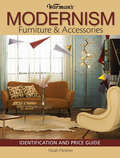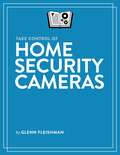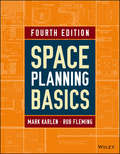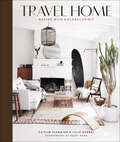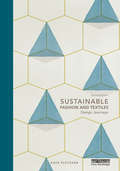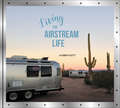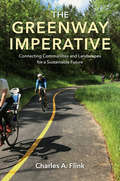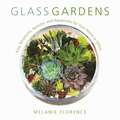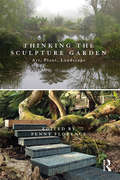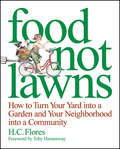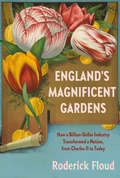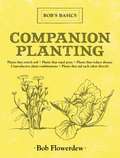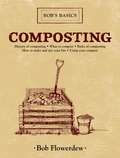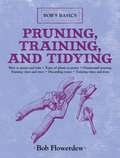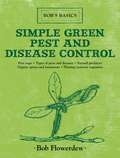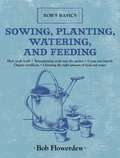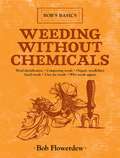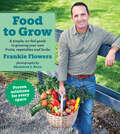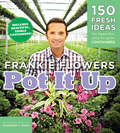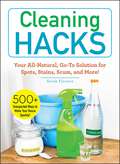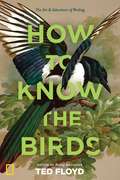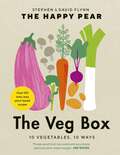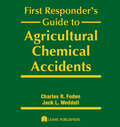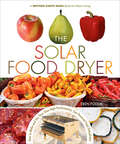- Table View
- List View
Warman's Modernism Furniture and Acessories: Identification and Price Guide (Warman's)
by Noah FleisherThe cool designs, sleek lines and fashion-forward forms of the open and optimistic feel of the modernism furniture and design is as reflective of attitude as it is ingenuity. The enthusiasm and boundless hope of post-War 1950s America, not unlike our country's current eagerness for a shot of optimism, is represented in the pages of this beautifully illustrated, inspiring, and informative book. Warman's Modernism Furniture & Accessories features the furniture and designs that emerged during the prime of the movement, between 1945 and 1985. The collection of 1,000 rich and robust color photos, real-world auction prices and extensive descriptions make this a fundamental reference for anyone with an interest in modernism furniture.
Take Control of Home Security Cameras
by Glenn FleishmanLearn everything you need to know about home security cameras to plan, purchase, and install the best system for your needs for live access, security monitoring, privacy concerns, and affordability.
Take Control of Home Security Cameras
by Glenn FleishmanLearn everything you need to know about home security cameras to plan, purchase, and install the best system for your needs for live access, security monitoring, privacy concerns, and affordability.
Space Planning Basics
by Rob Fleming Mark KarlenConquer the complexity of interior design with a logical, methodical approach Space Planning Basics is a definitive introduction and principle resource for thousands of designers. With step-by-step methodology based on the author's several decades of design experience, this authoritative guide has become the de facto reference for an entire generation of designers. This updated fourth edition includes digitized drawings, diagrams, and matrices throughout, and newly added supplemental photographs. The text has been revised to reflect the latest developments in sustainable and universal design, including coverage of daylighting, benchmarking, LEED system standards, and green code issues. The companion website provides AutoCAD files, intrustor videos and matrices to give you a deeper real-world understanding of the design process. This book is perfect preparation for the NCIDQ exam. Proper space planning goes way beyond sketching a preliminary floor plan. Successful implementation includes a balanced integration of code compliance, system support, and adherence to the client's functional needs. Sustainability adds a new, important layer of complexity. This book shows you how to approach space planning in a way that ensures all considerations are met, and nothing gets lost in the process. Adopt an organized and comprehensive planning methodology Work effectively with dimensionally challenging spaces Consider building systems, codes, lighting, acoustics, and more Develop advanced skills and conquer new challenges Space planning encompasses many components and processes, making a comprehensive reference necessary for mastery of the field. Space Planning Basics is a thorough, methodical resource that gets you started on the right track, with plenty of room for creativity.
Travel Home: Design with a Global Spirit
by Caitlin Flemming Julie Goebel“A peek inside the homes of tastemakers . . . A masterclass in how to infuse the ideas and finds you scoop up on the road into your digs back home.” —ChairishA road map for bringing far-flung design ideas back home, Travel Home shows us how to curate interiors that reflect our favorite places and experiences in ways that are beautiful and authentic. Touring the homes of leaders in global design who share a deep affection for travel, the book explores interiors with influences as widespread as Marrakesh, Paris, Cuba, Tokyo, Portugal, and beyond. Vivid photography is supplemented with insightful essays, interviews, and hardworking tips for cultivating your own global home. For globetrotters and armchair travelers alike, Travel Home showcases the interplay between travel and design, revealing how we can take inspiration from the beauty we experience in the world and bring it into our everyday lives. “The book is a study of how travel informs our taste—and a beautiful illustration of the creative potential a mother-daughter partnership can yield.” —goop “Upon finishing Travel Home I felt inspired in the same way that I feel inspired after a big trip. It’s a book you’re going to want to take notes in, take pictures of, and share with your friends. It will be a book very well loved.” —Justina Blakeney, designer and New York Times-bestselling author of Jungalow“There are so many books about interiors, but this book is a genuine opportunity to get to know the people and the mentality behind their spaces.” —Nate Berkus and Jeremiah Brent, authors and television stars on Nate & Jeremiah by Design
Sustainable Fashion and Textiles: Design Journeys
by Kate FletcherFully revised and updated, the second edition of Sustainable Fashion and Textiles: Design Journeys continues to define the field of design in fashion and textiles. Arranged in two sections, the first four chapters represent key stages of the lifecycle: material cultivation/extraction, production, use and disposal. The remaining four chapters explore design approaches for altering the scale and nature of consumption, including service design, localism, speed and user involvement. While each chapter is complete in and of itself, their real value comes from what they represent together: innovative ways of thinking about textiles and garments based on sustainability values and an interconnected approach to design. Including a new preface, updated content and a new conclusion reflecting and critiquing developments in the field, as well as discussing future developments, the second edition promises to provide further impetus for future change, sealing Sustainable Fashion and Textiles: Design Journeys as the must-buy book for fashion and textiles professionals and students interested in sustainability.
Living the Airstream Life
by Karen FlettIllustrated with rare and exclusive images from the official company archives, an authoritative and entertaining guide to the wildly popular, beautifully designed luxury recreational vehicle that has become a cultural icon, embodying the American spirit of freedom and adventure—and the ideal in mobile living.With its distinctive silver-bullet shaped profile, the Airstream has been an integral part of the American recreational landscape for more than eighty-five years. Since the 1930s, thousands of Americans have used it as a personal canvas to paint their own unique story as they’ve traveled the road of life, and today, these stunning, nostalgia-laden vehicles are more popular than ever. In Living the Airstream Life, Karen Flett tells the unique story of the designers who have transformed the brand into a mainstay of American life and the dreamers who have found their home, and their heart, in an Airstream. Living the Airstream Life is a tour along the diverse roads aficionados have taken in chasing their Airstream dreams. Stunning color photographs featuring new and vintage versions and compelling stories capture the allure of the Airstream and offer advice and insight on the practicalities of adopting this lifestyle. With spectacular photography and compelling stories, Living the Airstream Life offers inspiration for those actively pursing the dream of life on the road—whether for permanent living or as a temporary escape from the daily grind—and everyone who wants to live vicariously through those who dare.
The Greenway Imperative: Connecting Communities and Landscapes for a Sustainable Future
by Charles A. FlinkTrailblazing greenway projects from vision to reality In this eye-opening journey through some of America’s most innovative landscape architecture projects, Charles Flink shows why we urgently need greenways. A leading authority in greenway planning, design, and development, Flink presents inspiring examples of communities that have come together to build permanent spaces for the life-sustaining power of nature. The Greenway Imperative reveals the stories behind a variety of multiuse natural corridors, taking readers to Grand Canyon National Park, suburban North Carolina, the banks of the Miami River, and many other settings. Flink, who was closely involved with each of the projects in this book during his 35-year career, introduces the people who jumpstarted these initiatives and the challenges they overcame in achieving them. Flink explains why open green spaces are increasingly critical today. “Much more than a path through the woods,” he says, greenways conserve irreplaceable real estate for the environment, serve as essential green infrastructure, shape the way people travel within their communities, reduce impact from flooding and other natural disasters, and boost the economies of cities and towns. Greenways can and should dramatically reshape the landscape of America in the coming years, Flink argues. He provides valuable reflections and guidance on how we can create resilient communities and satisfy the human need for connection with the natural world.
Glass Gardens: Easy Terrariums, Aeriums, and Aquariums for Your Home or Office
by Melanie FlorenceNot everyone can be Martha Stewart, and luckily you don’t need to be to create beautiful terrariums to display in your space or to give as a gift. With simple instructions and a relaxed and pleasant tone, Glass Gardens speaks to the beginner terrarium-maker as a best friend would over a cup of coffee or tea. You won’t find any overly elaborate or complicated projects here! With just a few supplies and a small amount of time, you’ll have a gorgeous centerpiece to display or give away.Learn how to create stunning, easy-to-maintain terrariums with cacti and succulents, as well as water terrariums (aquariums) with plants you can buy at your local pet store and air terrariums (aeriums), which are by far the easiest type of terrarium to create and keep alive.In Glass Gardens, you’ll be given lists of supplies you’ll need as well as information on where to find them in addition to tips and tricks about the best ways to keep your plants alive and thriving. Easy, step-by-step instructions and detailed photos will have you designing your own glass gardens before you know it.
Thinking the Sculpture Garden: Art, Plant, Landscape
by Penny FlorenceThis innovative book poses two, deceptively simple, questions: what is a sculpture garden, and what happens when you give equal weight to the main elements of landscape, planting and artwork? Its wide-ranging frame of reference, including the USA, Europe and Japan, is brought into focus through Tremenheere Sculpture Garden, Cornwall, with which the book begins and ends. Effectively less than 15 years old, and largely the work of one man, Tremenheere affords an opportunity to examine as work-in-progress the creation of a new kind of sculpture garden. Including a historical overview, the book traverses multiple ways of seeing and experiencing sculpture gardens, culminating in an exploration of their relevance as 'cultural ecology' in the context of globalisation, urbanisation and climate change. The thinking here is non-dualist and broadly aligned with New Materialisms and Material Feminisms to explore our place as humans in the non-human world on which we depend. Eminent contributors, including John Dixon Hunt, George Descombes, Bernard Lassus and David Leatherbarrow, approach these issues through practices and theories of landscape architecture; garden and art making; history and writing; and philosophy. Richly illustrated with over 100 images, including a colour plate section, the book will primarily appeal to those engaged in professional or academic research, along with sculpture garden visitors, who will find new and surprising ways of experiencing plants and art in natural and urban settings.
Food Not Lawns
by H. C. FloresGardening can be a political act. Creativity, fulfillment, connection, revolution-it all begins when we get our hands in the dirt. "Food Not Lawns" combines practical wisdom on ecological design and community-building with a fresh, green perspective on an age-old subject. Activist and urban gardener Heather Flores shares her nine-step permaculture design to help farmsteaders and city dwellers alike build fertile soil, promote biodiversity, and increase natural habitat in their own "paradise gardens. " But "Food Not Lawns" doesn't begin and end in the seed bed. This joyful permaculture lifestyle manual inspires readers to apply the principles of the paradise garden--simplicity, resourcefulness, creativity, mindfulness, and community-to all aspects of life. Plant "guerilla gardens" in barren intersections and medians; organize community meals; start a street theater troupe or host a local art swap; free your kitchen from refrigeration and enjoy truly fresh, nourishing foods from your own plot of land; work with children to create garden play spaces. Flores cares passionately about the damaged state of our environment and the ills of our throwaway society. In "Food Not Lawns," she shows us how to reclaim the earth one garden at a time.
England's Magnificent Gardens: How a Billion-Dollar Industry Transformed a Nation, from Charles II to Today
by Roderick FloudAn altogether different kind of book on English gardens—the first of its kind—a look at the history of England&’s magnificent gardens as a history of Britain itself, from the seventeenth-century gardens of Charles II to those of Prince Charles today. In this rich, revelatory history, Sir Roderick Floud, one of Britain&’s preeminent economic historians, writes that gardens have been created in Britain since Roman times but that their true growth began in the seventeenth century; by the eighteenth century, nurseries in London took up 100 acres, with ten million plants (!) that were worth more than all of the nurseries in France combined. Floud&’s book takes us through more than three centuries of English history as he writes of the kings, queens, and princes whose garden obsessions changed the landscape of England itself, from Stuart, Georgian, and Victorian England to today&’s Windsors. Here are William and Mary, who brought Dutch gardens and bulbs to Britain; William, who twice had his entire garden lowered in order to see the river from his apartments; and his successor, Queen Anne, who, like many others since, vowed to spend little on her gardens and instead spent millions. Floud also writes of Frederick, Prince of Wales, the founder of Kew Gardens, who spent more than $40,000 on a single twenty-five-foot tulip tree for Carlton House; Queen Victoria, who built the largest, most advanced and most efficient kitchen garden in Britain; and Prince Charles, who created and designed the gardens of Highgrove, inspired by his boyhood memories of his grandmother&’s gardens. We see Sarah, Duchess of Marlborough, who created a magnificent garden at Blenheim Palace, only to tear it apart and build a greater one; Deborah, Duchess of Devonshire, the savior of Chatsworth&’s 100-acre garden in the midst of its 35,000 acres; and the gardens of lesser mortals, among them Gertrude Jekyll and Vita Sackville-West, both notable garden designers and writers. We see the designers of royal estates—among them, Henry Wise, William Kent, Humphrey Repton, and the greatest of all English gardeners, &“Capability&” Brown, who created the 150-acre lake of Blenheim Palace, earned millions annually, and designed more than 170 parks, many still in existence today. We learn how gardening became a major catalyst for innovation (central heating came from experiments to heat greenhouses with hot-water pipes); how the new iron industry of industrializing Britain supplied a myriad of tools (mowers, pumps, and the boilers that heated the greenhouses); and, finally, Floud explores how gardening became an enormous industry as well as an art form in Britain, and by the nineteenth century was unrivaled anywhere in the world.
Companion Planting: Bob's Basics (Bob's Basics)
by Bob FlowerdewAccording to Flowerdew, the key to successful organic gardening is working with nature, rather than against it, to get your plants to thrive. This practice is called companion planting, and it is explained in this volume with a style that is both no-nonsense and reader-friendly. Topics range from plants that compete for nutrients to plants that enrich their soil for future crops. Gardeners of all levels will learn from Companion Planting and their gardens will benefit from happy and healthy plants.
Composting: Bob's Basics (Bob's Basics)
by Bob FlowerdewThe best fertilizer for your organic garden is compost. It's easy to make, economically friendly, and teeming with nutrients. In this highly useful installment of his Bob's Basics series, Bob Flowerdew takes you through all the steps necessary to make a rich compost pile best suited to your needs. Composting is a highly comprehensive guide that goes over all the steps, from building a bin to collecting material to maintaining and adding to the finished product.
Pruning, Training, and Tidying: Bob's Basics (Bob's Basics)
by Bob FlowerdewWhat sets Bob Flowerdew's Pruning, Training, and Tidying apart from other books on the subject is that it does not advise pruning every single plant in your garden. Rather, as Flowerdew puts it, this guide explains the simplest basics of pruning, and how to get admirable results without obsessing over the growing pattern of every plant. Whatever you are growing, and whatever your garden looks like, Pruning, Training, and Tidying will help you to keep your garden beautiful and functional.
Simple Green Pest and Disease Control: Bob's Basics (Bob's Basics)
by Bob FlowerdewOne of the biggest challenges of growing an organic garden is keeping away pests and diseases without using harmful pesticides. But as Bob illustrates in this necessary guide for any organic gardener, it is possible to keep your garden chemical-, pest-, and disease-free all at once. A master at growing organic produce, Flowerdew outlines the best natural methods, from building effective physical barriers and pest traps out of plants and recycled materials to using such natural pest predators as birds, reptiles, and even other bugs.
Sowing, Planting, Watering, and Feeding: Bob's Basics (Bob's Basics)
by Bob FlowerdewYou most likely already know that nurturing a planted seed is necessary for growing a healthy plant. But how do you know the right amount of water to give? What are the best kinds of organic fertilizers? How can you plant a seed to set it on the right track for optimal growth? In Sowing, Planting, Watering, and Feeding, Bob Flowerdew guides you through these and other quandaries, and provides practical advice for dodging common mistakes gardeners make when nurturing their seedlings.
Weeding Without Chemicals: Bob's Basics (Bob's Basics)
by Bob FlowerdewThe nuisance caused by weeds sprouting in your otherwise thriving garden may make you want to reach for the herbicide, but as Flowerdew writes in this installment of his Bob's Basics series, weed control can be much more simple, inexpensive, and eco-friendly without chemical intervention. Because every weed is best removed with a different method, Weeding Without Chemicals begins with a discussion of the various weed categories. No matter what sort of weed is plaguing your garden, Bob has a chemical-free way to keep it under control.
Food to Grow EPB (FXL): A simple, no-fail guide to growing your own vegetables, fruits and herbs
by Frankie FlowersFrom Canada’s #1 garden team, a guide that makes growing your own fruits, vegetables and herbs simple, bountiful and funNothing beats the taste and smell of a tomato freshly picked from your own garden. And there’s a certain pride in knowing that the salad you just served—fresh strawberries and all—was harvested entirely from your backyard. But growing your own fruits, vegetables and herbs can be time-consuming and feel overwhelmingly complicated. Your eagerness to get growing in the spring can be rained out by seemingly endless seedlings and seed packs at your garden centre, all with cryptic planting instructions that leave you with withered plants rather than crunchy carrots. But it doesn’t need to be that way! Frankie Flowers has decades of experience helping thumbs of all colours turn barren patches and empty pots into bountiful harvests—and he can help you do the same.Food to Grow simplifies every growing decision you’ll need to make. Frankie helps you evaluate your space, decide just how much time you want to invest and then make the smartest choices about which plants will give you the best bang for your buck. He guides you through the entire growing season from prepping and planning, to planting, weeding and harvesting (the best part!), and he shares not just which veggies, fruits and herbs have become Frankie’s Favourites, but also which plants just aren’t worth the effort.Loaded with gorgeous photography that will have you desperate to get digging, Food to Grow includes a detailed A–Z index of over fifty of Canada’s most popular home crops. Whether you have space for a few pots or a back forty, Frankie Flowers will help you make your dream of home-grown treats a fun and tasty reality.
Pot It Up: 150 Fresh Ideas for Beautiful, Easy-to-Grow Containers
by Frankie FlowersContainers are a gardener’s best friend—they make it easy and fun to bring a burst of life and colour to your porch, balcony or front step. But so many of us get stuck in a rut. Frankie Flowers is here with 150 inspiring, beautiful and sometimes surprising container ideas to get your juices flowing. Each plays with Frankie’s signature technique of using a thriller, a filler and a spiller to make sure your pot will have maximum impact. Frankie gives you the breakdown on which plants he’s used, and to which conditions they’re best suited. And if you’re feeling a little peckish, Frankie’s even got some delicious edibles for you to throw into the mix. With Frankie’s step-by-step instructions, and the don’t-sweat-it attitude readers came to love in his first bestseller, Get Growing, Frankie’s Pot It Up will have the whole country going to pot—in the best way possible!
Cleaning Hacks: Your All-Natural, Go-To Solution for Spots, Stains, Scum, and More! (Hacks)
by Sarah FlowersClean everything in your home from your clothes and sheets to your shower curtain, vents—even the inside of your washing machine—with this simple short-cuts using all-natural cleaning products. Did you know you should be cleaning your sponge on a weekly basis by putting it in the microwave for just 90 seconds? Or that you could use a rubber glove to clean up pet hair instead of a lint brush? Or that wax paper can be used to make your faucets and sink fixtures shine instead of a chemical polish? Avoid long lists of mysterious chemicals and skip buying multiple cleaning products and get back to basics and use simple, all-natural solutions that are safe, inexpensive, and effective. Take control of your cleaning to-do list with these easy, natural cleaning methods. With this book, you’ll learn to: —Use vinegar to clean out a washing machine that’s starting to smell —Mix lemon juice and salt to really clean out the cracks in your cutting board where food can get stuck —Rub chalk onto a greasy stain to help absorb extra oils before washing And much more! Organized by cleaning project, you’ll be able to find the perfect easy solution for all your cleaning jobs, however large or small, with this handy guide!
How to Know the Birds: The Art and Adventure of Birding
by Ted FloydBecome a better birder with brief portraits of 200 top North American birds. This friendly, relatable book is a celebration of the art, science, and delights of bird-watching.How to Know the Birds introduces a new, holistic approach to bird-watching, by noting how behaviors, settings, and seasonal cycles connect with shape, song, color, gender, age distinctions, and other features traditionally used to identify species. With short essays on 200 observable species, expert author Ted Floyd guides us through a year of becoming a better birder, each species representing another useful lesson: from explaining scientific nomenclature to noting how plumage changes with age, from chronicling migration patterns to noting hatchling habits. Dozens of endearing pencil sketches accompany Floyd's charming prose, making this book a unique blend of narrative and field guide. A pleasure for birders of all ages, this witty book promises solid lessons for the beginner and smiles of recognition for the seasoned nature lover.
The Veg Box: 10 Vegetables, 10 Ways
by David Flynn Stephen FlynnDavid and Stephen Flynn, a.k.a the Happy Pear twins, are back with their simplest cookbook yet!The perfect collection for vegans, vegetarians, or anyone looking to eat more plant-based recipes - 'This book is awesome' Chris EvansAUBERGINE - BEETROOT - BROCCOLI - CABBAGE - CARROT - CAULIFLOWER - COURGETTE - LEEK - MUSHROOMS - POTATOESTen vegetables, ten ways, The Veg Box makes cooking veg easier and tastier than ever before! This vibrant book is packed with over 100 new recipes that use just ten ingredients or less and showcase the delicious and diverse ways you can enjoy each vegetable.Take carrots for example. Learn how to transform this simple produce into:Carrot and Sesame BurgersRoasted Carrot TagineChewy Flapjacks with Carrot and PistachioOr how about courgettes? Watch them become:Easy One-Pan Courgette PizzaCourgette Crepes with Spinach and RicottaCourgette and Lemon Loaf Cake with a Lemon Curd Building tips on eating more sustainably into family-friendly meals, quick weeknight dinners and sweet treats, this is healthy eating for our planet, our bodies and our tastebuds.'Proper good food, less waste and very simple, delicious plant-based recipes' Joe Wicks'Super practical and full of great recipes for eating more plants and reducing food waste' Fearne Cotton 'The lads have done it again! A great concept and a beautiful book to help us all cook more delicious veg' BOSH!'A delicious celebration of plants and all that they have to offer' Megan Rossi 'Their recipes are fantastic and you will love this book' Dr Rupy Aujla 'Delicious, sustainable meals everyone will enjoy' Dr Gemma Newman
First Responder's Guide to Agricultural Chemical Accidents
by Charles R. Foden Jack L. WeddellFirst Responder's Guide to Agricultural Chemical Accidents provides emergency safety and health information for 452 toxic and hazardous products. These products, frequently used by pest exterminators and farmers, include those insecticides, pesticides, rodenticides, herbicides, and fertilizers commonly transported on highways and by rail carriers. The book lists products alphabetically and includes the manufacturer and telephone number, chemical identification, physical properties, hazard ratings, neutralizing agents (when known), fire fighting agents, special warnings, evacuation distances, protective clothing, health hazard information, and emergency first aid for exposure. This important information allows any First Responder to establish a safe plan of action without having to reference the library of chemical books normally carried by a Hazardous Materials Emergency Response Team (HERT).First Responder's Guide to Agricultural Chemical Accidents is an essential reference that provides critical hazardous materials data for personnel at fire departments, law enforcement agencies, and emergency medical agencies. The book will also be useful for business or individuals that store, sell, or use agricultural chemicals.
The Solar Food Dryer: How to Make and Use Your Own High-Performance, Sun-Powered Food Dehydrator (Mother Earth News Books for Wiser Living)
by Eben V. FodorThe Solar Food Dryer describes how to use solar energy to dry your food instead of costly electricity. With your own solar-powered food dryer, you can quickly and efficiently dry all your extra garden veggies, fruits, and herbs to preserve their goodness all year long--with free sunshine! Applicable to a wide geography--wherever gardens grow--this well-illustrated book includes:* Complete step-by-step plans for building a high-performance, low-cost solar food dryer from readily available materials * Solar energy design concepts * Food drying tips and recipes * Resources, references, solar charts, and moreEben Fodor is an organic gardener with a background in solar energy and engineering. He works as a community planning consultant in Eugene, Oregon.
